Evaluating Nuclear Energy: A Critical Look at Sustainability
VerifiedAdded on 2023/06/11
|7
|1828
|363
Essay
AI Summary
This essay examines the sustainability of nuclear energy as a crucial alternative to renewable and non-renewable sources. It addresses the advantages of nuclear power, such as its potential to reduce greenhouse gas emissions and its cost-effectiveness, while also acknowledging the risks associated with nuclear accidents and radioactive waste. The essay explores arguments for and against nuclear energy, referencing events like the Fukushima Daiichi disaster and technological advancements aimed at preventing such incidents. It also contrasts nuclear energy with other renewable sources, highlighting its reliability and efficiency. The conclusion posits that, with effective safety measures and waste management, nuclear energy can serve as a sustainable source capable of meeting global energy demands, especially given the limitations and environmental impacts of other energy options. Desklib offers a platform to access this and many other resources for students.
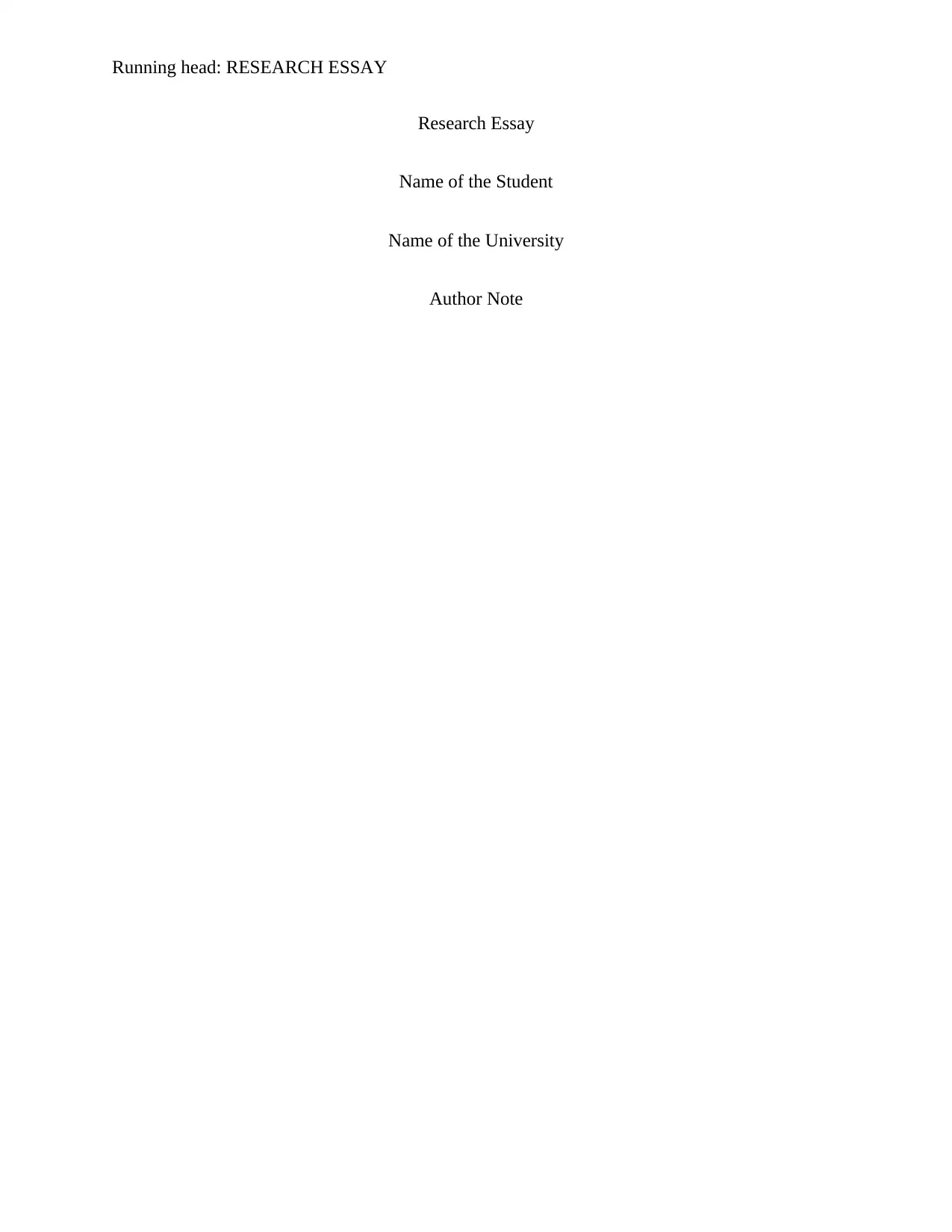
Running head: RESEARCH ESSAY
Research Essay
Name of the Student
Name of the University
Author Note
Research Essay
Name of the Student
Name of the University
Author Note
Paraphrase This Document
Need a fresh take? Get an instant paraphrase of this document with our AI Paraphraser
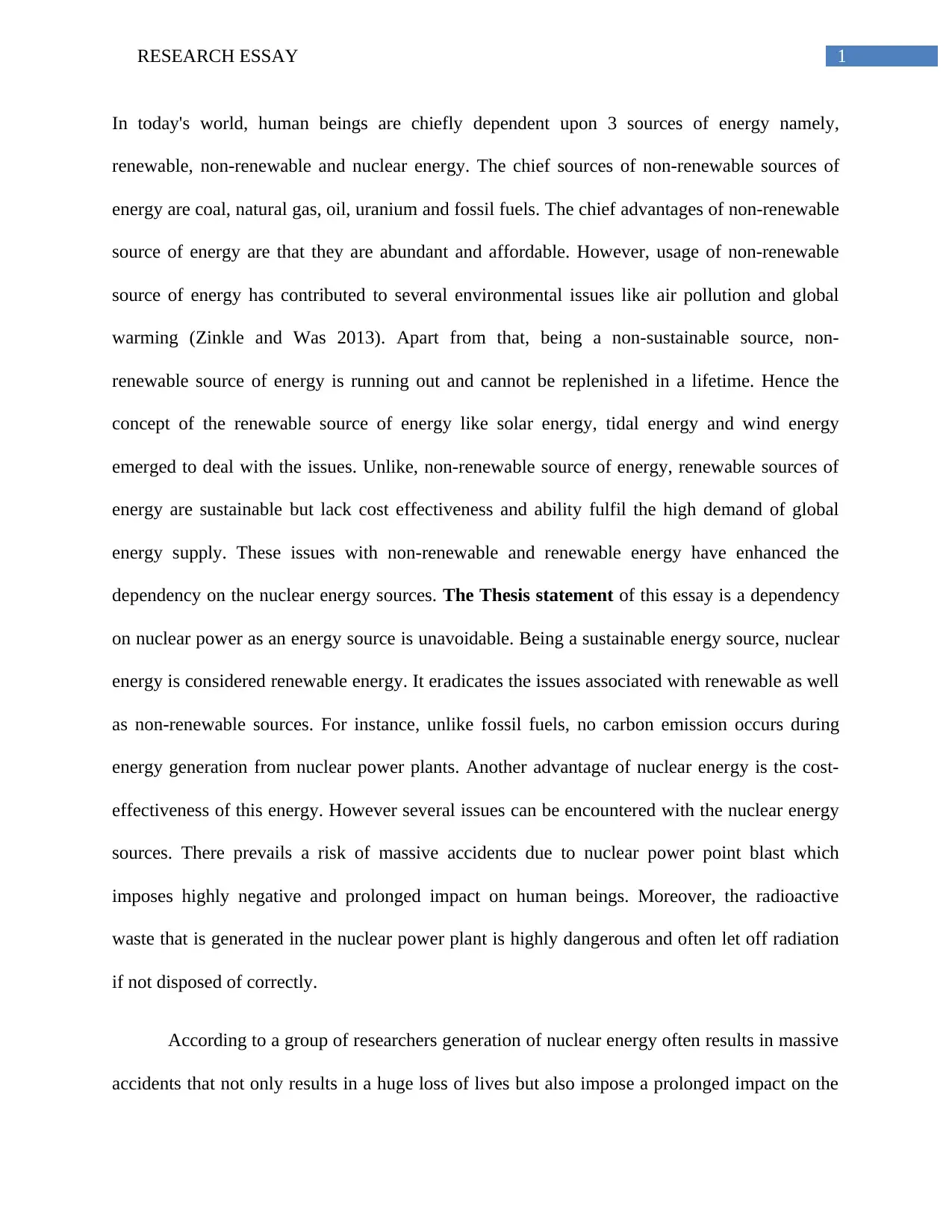
1RESEARCH ESSAY
In today's world, human beings are chiefly dependent upon 3 sources of energy namely,
renewable, non-renewable and nuclear energy. The chief sources of non-renewable sources of
energy are coal, natural gas, oil, uranium and fossil fuels. The chief advantages of non-renewable
source of energy are that they are abundant and affordable. However, usage of non-renewable
source of energy has contributed to several environmental issues like air pollution and global
warming (Zinkle and Was 2013). Apart from that, being a non-sustainable source, non-
renewable source of energy is running out and cannot be replenished in a lifetime. Hence the
concept of the renewable source of energy like solar energy, tidal energy and wind energy
emerged to deal with the issues. Unlike, non-renewable source of energy, renewable sources of
energy are sustainable but lack cost effectiveness and ability fulfil the high demand of global
energy supply. These issues with non-renewable and renewable energy have enhanced the
dependency on the nuclear energy sources. The Thesis statement of this essay is a dependency
on nuclear power as an energy source is unavoidable. Being a sustainable energy source, nuclear
energy is considered renewable energy. It eradicates the issues associated with renewable as well
as non-renewable sources. For instance, unlike fossil fuels, no carbon emission occurs during
energy generation from nuclear power plants. Another advantage of nuclear energy is the cost-
effectiveness of this energy. However several issues can be encountered with the nuclear energy
sources. There prevails a risk of massive accidents due to nuclear power point blast which
imposes highly negative and prolonged impact on human beings. Moreover, the radioactive
waste that is generated in the nuclear power plant is highly dangerous and often let off radiation
if not disposed of correctly.
According to a group of researchers generation of nuclear energy often results in massive
accidents that not only results in a huge loss of lives but also impose a prolonged impact on the
In today's world, human beings are chiefly dependent upon 3 sources of energy namely,
renewable, non-renewable and nuclear energy. The chief sources of non-renewable sources of
energy are coal, natural gas, oil, uranium and fossil fuels. The chief advantages of non-renewable
source of energy are that they are abundant and affordable. However, usage of non-renewable
source of energy has contributed to several environmental issues like air pollution and global
warming (Zinkle and Was 2013). Apart from that, being a non-sustainable source, non-
renewable source of energy is running out and cannot be replenished in a lifetime. Hence the
concept of the renewable source of energy like solar energy, tidal energy and wind energy
emerged to deal with the issues. Unlike, non-renewable source of energy, renewable sources of
energy are sustainable but lack cost effectiveness and ability fulfil the high demand of global
energy supply. These issues with non-renewable and renewable energy have enhanced the
dependency on the nuclear energy sources. The Thesis statement of this essay is a dependency
on nuclear power as an energy source is unavoidable. Being a sustainable energy source, nuclear
energy is considered renewable energy. It eradicates the issues associated with renewable as well
as non-renewable sources. For instance, unlike fossil fuels, no carbon emission occurs during
energy generation from nuclear power plants. Another advantage of nuclear energy is the cost-
effectiveness of this energy. However several issues can be encountered with the nuclear energy
sources. There prevails a risk of massive accidents due to nuclear power point blast which
imposes highly negative and prolonged impact on human beings. Moreover, the radioactive
waste that is generated in the nuclear power plant is highly dangerous and often let off radiation
if not disposed of correctly.
According to a group of researchers generation of nuclear energy often results in massive
accidents that not only results in a huge loss of lives but also impose a prolonged impact on the
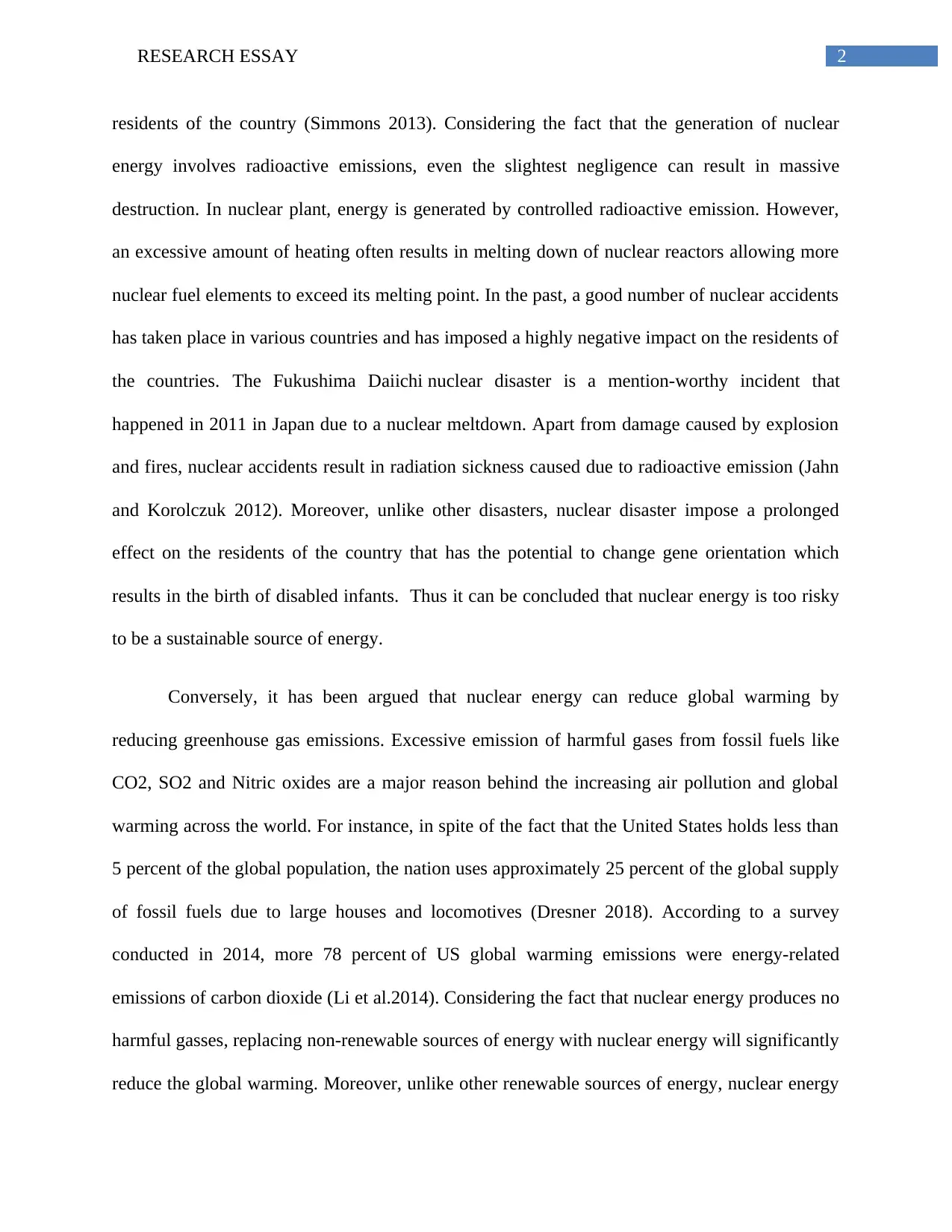
2RESEARCH ESSAY
residents of the country (Simmons 2013). Considering the fact that the generation of nuclear
energy involves radioactive emissions, even the slightest negligence can result in massive
destruction. In nuclear plant, energy is generated by controlled radioactive emission. However,
an excessive amount of heating often results in melting down of nuclear reactors allowing more
nuclear fuel elements to exceed its melting point. In the past, a good number of nuclear accidents
has taken place in various countries and has imposed a highly negative impact on the residents of
the countries. The Fukushima Daiichi nuclear disaster is a mention-worthy incident that
happened in 2011 in Japan due to a nuclear meltdown. Apart from damage caused by explosion
and fires, nuclear accidents result in radiation sickness caused due to radioactive emission (Jahn
and Korolczuk 2012). Moreover, unlike other disasters, nuclear disaster impose a prolonged
effect on the residents of the country that has the potential to change gene orientation which
results in the birth of disabled infants. Thus it can be concluded that nuclear energy is too risky
to be a sustainable source of energy.
Conversely, it has been argued that nuclear energy can reduce global warming by
reducing greenhouse gas emissions. Excessive emission of harmful gases from fossil fuels like
CO2, SO2 and Nitric oxides are a major reason behind the increasing air pollution and global
warming across the world. For instance, in spite of the fact that the United States holds less than
5 percent of the global population, the nation uses approximately 25 percent of the global supply
of fossil fuels due to large houses and locomotives (Dresner 2018). According to a survey
conducted in 2014, more 78 percent of US global warming emissions were energy-related
emissions of carbon dioxide (Li et al.2014). Considering the fact that nuclear energy produces no
harmful gasses, replacing non-renewable sources of energy with nuclear energy will significantly
reduce the global warming. Moreover, unlike other renewable sources of energy, nuclear energy
residents of the country (Simmons 2013). Considering the fact that the generation of nuclear
energy involves radioactive emissions, even the slightest negligence can result in massive
destruction. In nuclear plant, energy is generated by controlled radioactive emission. However,
an excessive amount of heating often results in melting down of nuclear reactors allowing more
nuclear fuel elements to exceed its melting point. In the past, a good number of nuclear accidents
has taken place in various countries and has imposed a highly negative impact on the residents of
the countries. The Fukushima Daiichi nuclear disaster is a mention-worthy incident that
happened in 2011 in Japan due to a nuclear meltdown. Apart from damage caused by explosion
and fires, nuclear accidents result in radiation sickness caused due to radioactive emission (Jahn
and Korolczuk 2012). Moreover, unlike other disasters, nuclear disaster impose a prolonged
effect on the residents of the country that has the potential to change gene orientation which
results in the birth of disabled infants. Thus it can be concluded that nuclear energy is too risky
to be a sustainable source of energy.
Conversely, it has been argued that nuclear energy can reduce global warming by
reducing greenhouse gas emissions. Excessive emission of harmful gases from fossil fuels like
CO2, SO2 and Nitric oxides are a major reason behind the increasing air pollution and global
warming across the world. For instance, in spite of the fact that the United States holds less than
5 percent of the global population, the nation uses approximately 25 percent of the global supply
of fossil fuels due to large houses and locomotives (Dresner 2018). According to a survey
conducted in 2014, more 78 percent of US global warming emissions were energy-related
emissions of carbon dioxide (Li et al.2014). Considering the fact that nuclear energy produces no
harmful gasses, replacing non-renewable sources of energy with nuclear energy will significantly
reduce the global warming. Moreover, unlike other renewable sources of energy, nuclear energy
⊘ This is a preview!⊘
Do you want full access?
Subscribe today to unlock all pages.

Trusted by 1+ million students worldwide
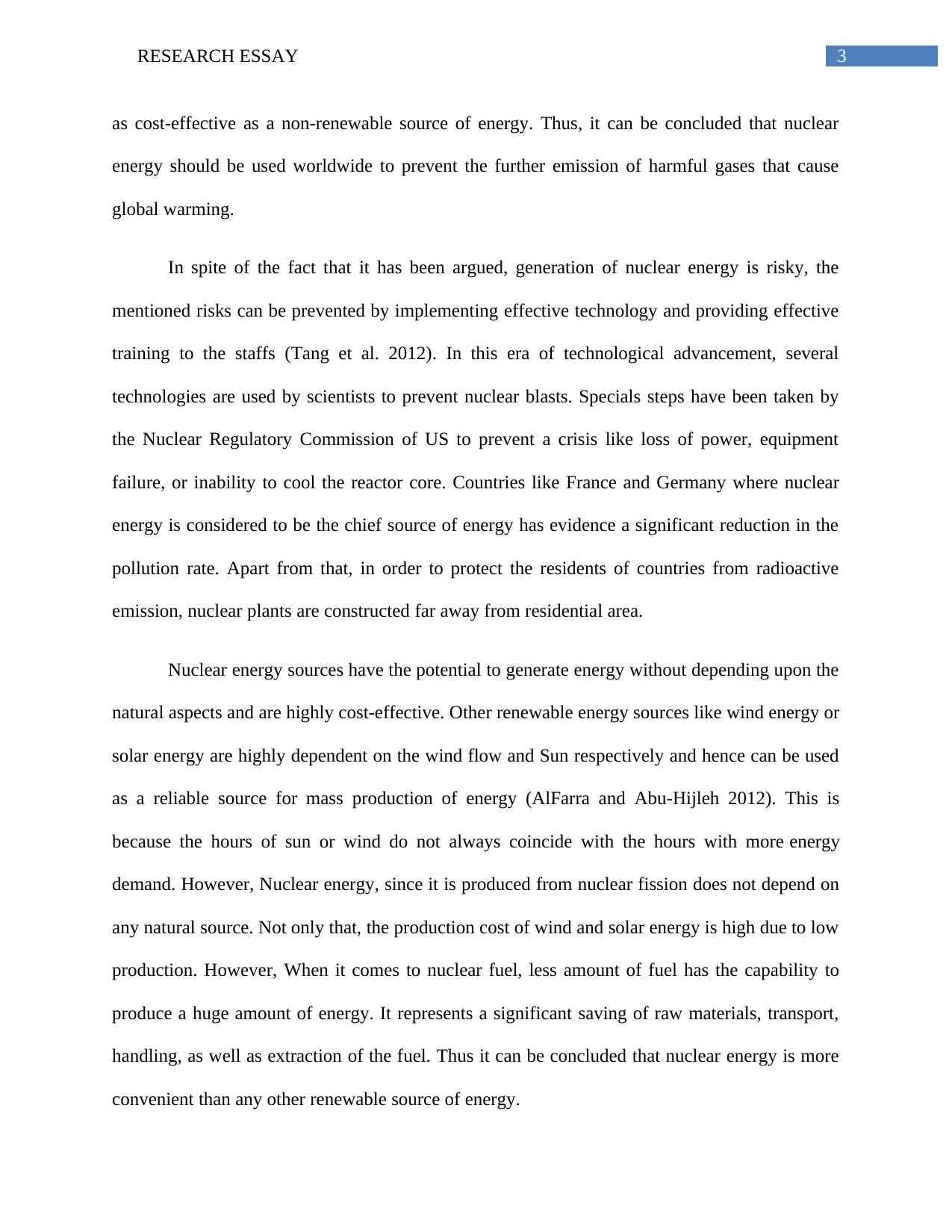
3RESEARCH ESSAY
as cost-effective as a non-renewable source of energy. Thus, it can be concluded that nuclear
energy should be used worldwide to prevent the further emission of harmful gases that cause
global warming.
In spite of the fact that it has been argued, generation of nuclear energy is risky, the
mentioned risks can be prevented by implementing effective technology and providing effective
training to the staffs (Tang et al. 2012). In this era of technological advancement, several
technologies are used by scientists to prevent nuclear blasts. Specials steps have been taken by
the Nuclear Regulatory Commission of US to prevent a crisis like loss of power, equipment
failure, or inability to cool the reactor core. Countries like France and Germany where nuclear
energy is considered to be the chief source of energy has evidence a significant reduction in the
pollution rate. Apart from that, in order to protect the residents of countries from radioactive
emission, nuclear plants are constructed far away from residential area.
Nuclear energy sources have the potential to generate energy without depending upon the
natural aspects and are highly cost-effective. Other renewable energy sources like wind energy or
solar energy are highly dependent on the wind flow and Sun respectively and hence can be used
as a reliable source for mass production of energy (AlFarra and Abu-Hijleh 2012). This is
because the hours of sun or wind do not always coincide with the hours with more energy
demand. However, Nuclear energy, since it is produced from nuclear fission does not depend on
any natural source. Not only that, the production cost of wind and solar energy is high due to low
production. However, When it comes to nuclear fuel, less amount of fuel has the capability to
produce a huge amount of energy. It represents a significant saving of raw materials, transport,
handling, as well as extraction of the fuel. Thus it can be concluded that nuclear energy is more
convenient than any other renewable source of energy.
as cost-effective as a non-renewable source of energy. Thus, it can be concluded that nuclear
energy should be used worldwide to prevent the further emission of harmful gases that cause
global warming.
In spite of the fact that it has been argued, generation of nuclear energy is risky, the
mentioned risks can be prevented by implementing effective technology and providing effective
training to the staffs (Tang et al. 2012). In this era of technological advancement, several
technologies are used by scientists to prevent nuclear blasts. Specials steps have been taken by
the Nuclear Regulatory Commission of US to prevent a crisis like loss of power, equipment
failure, or inability to cool the reactor core. Countries like France and Germany where nuclear
energy is considered to be the chief source of energy has evidence a significant reduction in the
pollution rate. Apart from that, in order to protect the residents of countries from radioactive
emission, nuclear plants are constructed far away from residential area.
Nuclear energy sources have the potential to generate energy without depending upon the
natural aspects and are highly cost-effective. Other renewable energy sources like wind energy or
solar energy are highly dependent on the wind flow and Sun respectively and hence can be used
as a reliable source for mass production of energy (AlFarra and Abu-Hijleh 2012). This is
because the hours of sun or wind do not always coincide with the hours with more energy
demand. However, Nuclear energy, since it is produced from nuclear fission does not depend on
any natural source. Not only that, the production cost of wind and solar energy is high due to low
production. However, When it comes to nuclear fuel, less amount of fuel has the capability to
produce a huge amount of energy. It represents a significant saving of raw materials, transport,
handling, as well as extraction of the fuel. Thus it can be concluded that nuclear energy is more
convenient than any other renewable source of energy.
Paraphrase This Document
Need a fresh take? Get an instant paraphrase of this document with our AI Paraphraser
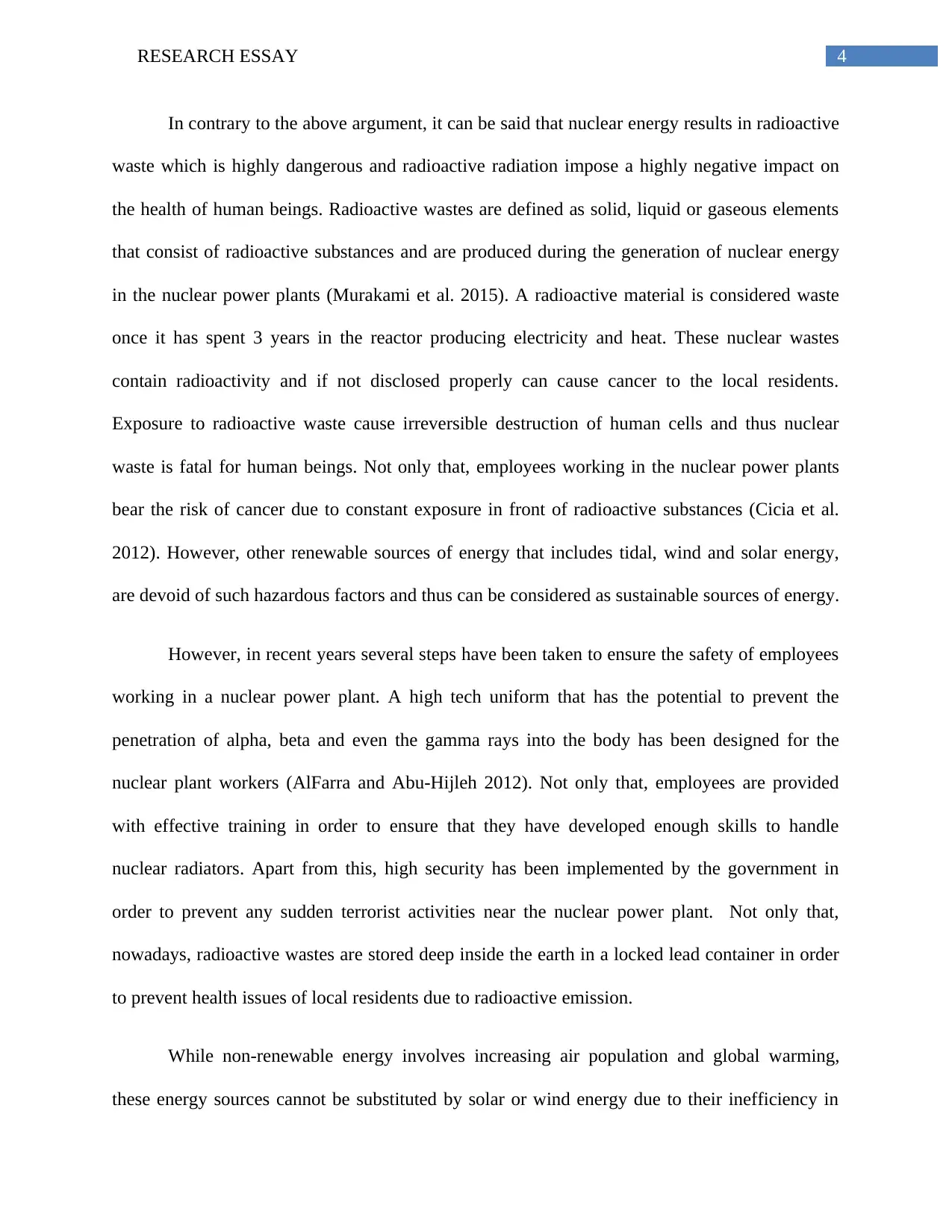
4RESEARCH ESSAY
In contrary to the above argument, it can be said that nuclear energy results in radioactive
waste which is highly dangerous and radioactive radiation impose a highly negative impact on
the health of human beings. Radioactive wastes are defined as solid, liquid or gaseous elements
that consist of radioactive substances and are produced during the generation of nuclear energy
in the nuclear power plants (Murakami et al. 2015). A radioactive material is considered waste
once it has spent 3 years in the reactor producing electricity and heat. These nuclear wastes
contain radioactivity and if not disclosed properly can cause cancer to the local residents.
Exposure to radioactive waste cause irreversible destruction of human cells and thus nuclear
waste is fatal for human beings. Not only that, employees working in the nuclear power plants
bear the risk of cancer due to constant exposure in front of radioactive substances (Cicia et al.
2012). However, other renewable sources of energy that includes tidal, wind and solar energy,
are devoid of such hazardous factors and thus can be considered as sustainable sources of energy.
However, in recent years several steps have been taken to ensure the safety of employees
working in a nuclear power plant. A high tech uniform that has the potential to prevent the
penetration of alpha, beta and even the gamma rays into the body has been designed for the
nuclear plant workers (AlFarra and Abu-Hijleh 2012). Not only that, employees are provided
with effective training in order to ensure that they have developed enough skills to handle
nuclear radiators. Apart from this, high security has been implemented by the government in
order to prevent any sudden terrorist activities near the nuclear power plant. Not only that,
nowadays, radioactive wastes are stored deep inside the earth in a locked lead container in order
to prevent health issues of local residents due to radioactive emission.
While non-renewable energy involves increasing air population and global warming,
these energy sources cannot be substituted by solar or wind energy due to their inefficiency in
In contrary to the above argument, it can be said that nuclear energy results in radioactive
waste which is highly dangerous and radioactive radiation impose a highly negative impact on
the health of human beings. Radioactive wastes are defined as solid, liquid or gaseous elements
that consist of radioactive substances and are produced during the generation of nuclear energy
in the nuclear power plants (Murakami et al. 2015). A radioactive material is considered waste
once it has spent 3 years in the reactor producing electricity and heat. These nuclear wastes
contain radioactivity and if not disclosed properly can cause cancer to the local residents.
Exposure to radioactive waste cause irreversible destruction of human cells and thus nuclear
waste is fatal for human beings. Not only that, employees working in the nuclear power plants
bear the risk of cancer due to constant exposure in front of radioactive substances (Cicia et al.
2012). However, other renewable sources of energy that includes tidal, wind and solar energy,
are devoid of such hazardous factors and thus can be considered as sustainable sources of energy.
However, in recent years several steps have been taken to ensure the safety of employees
working in a nuclear power plant. A high tech uniform that has the potential to prevent the
penetration of alpha, beta and even the gamma rays into the body has been designed for the
nuclear plant workers (AlFarra and Abu-Hijleh 2012). Not only that, employees are provided
with effective training in order to ensure that they have developed enough skills to handle
nuclear radiators. Apart from this, high security has been implemented by the government in
order to prevent any sudden terrorist activities near the nuclear power plant. Not only that,
nowadays, radioactive wastes are stored deep inside the earth in a locked lead container in order
to prevent health issues of local residents due to radioactive emission.
While non-renewable energy involves increasing air population and global warming,
these energy sources cannot be substituted by solar or wind energy due to their inefficiency in
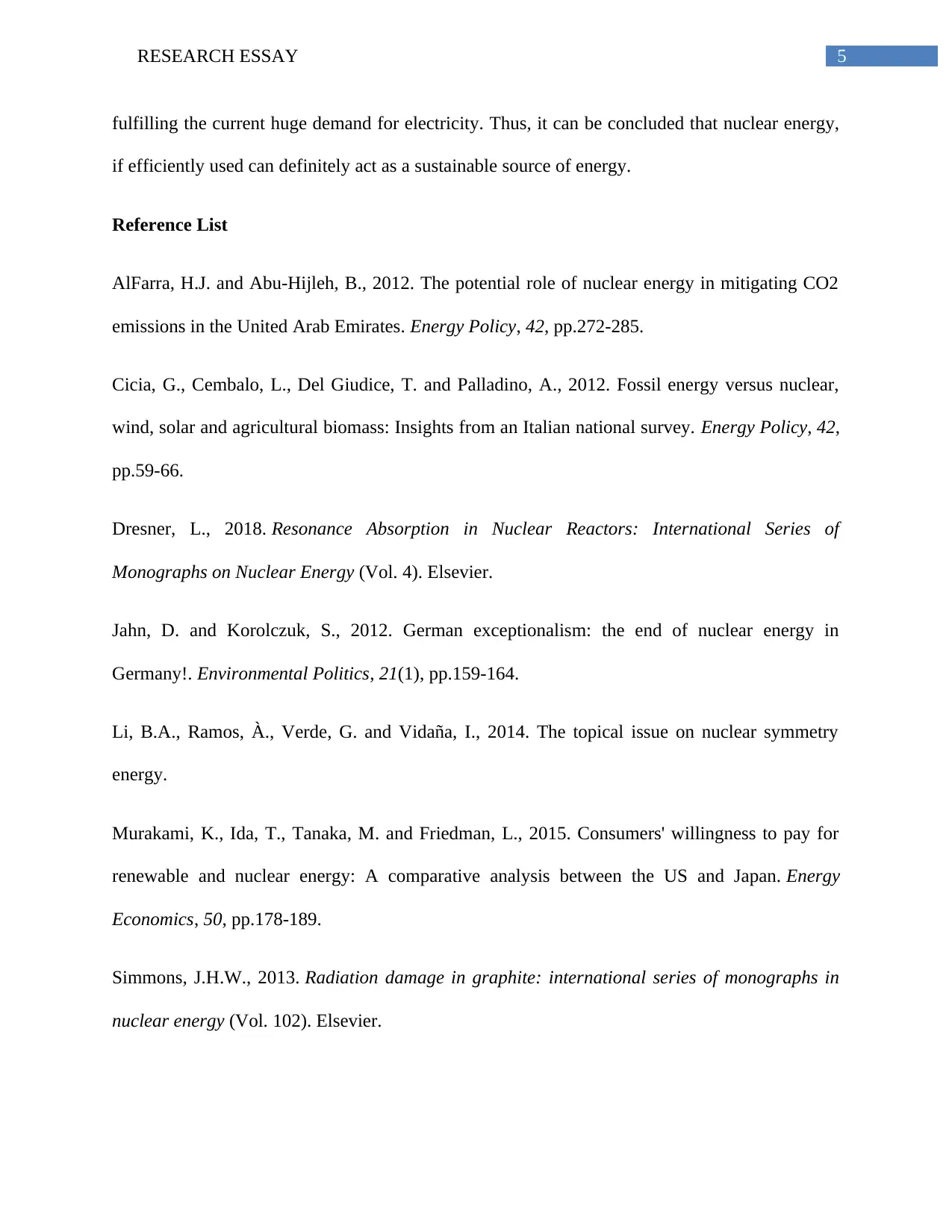
5RESEARCH ESSAY
fulfilling the current huge demand for electricity. Thus, it can be concluded that nuclear energy,
if efficiently used can definitely act as a sustainable source of energy.
Reference List
AlFarra, H.J. and Abu-Hijleh, B., 2012. The potential role of nuclear energy in mitigating CO2
emissions in the United Arab Emirates. Energy Policy, 42, pp.272-285.
Cicia, G., Cembalo, L., Del Giudice, T. and Palladino, A., 2012. Fossil energy versus nuclear,
wind, solar and agricultural biomass: Insights from an Italian national survey. Energy Policy, 42,
pp.59-66.
Dresner, L., 2018. Resonance Absorption in Nuclear Reactors: International Series of
Monographs on Nuclear Energy (Vol. 4). Elsevier.
Jahn, D. and Korolczuk, S., 2012. German exceptionalism: the end of nuclear energy in
Germany!. Environmental Politics, 21(1), pp.159-164.
Li, B.A., Ramos, À., Verde, G. and Vidaña, I., 2014. The topical issue on nuclear symmetry
energy.
Murakami, K., Ida, T., Tanaka, M. and Friedman, L., 2015. Consumers' willingness to pay for
renewable and nuclear energy: A comparative analysis between the US and Japan. Energy
Economics, 50, pp.178-189.
Simmons, J.H.W., 2013. Radiation damage in graphite: international series of monographs in
nuclear energy (Vol. 102). Elsevier.
fulfilling the current huge demand for electricity. Thus, it can be concluded that nuclear energy,
if efficiently used can definitely act as a sustainable source of energy.
Reference List
AlFarra, H.J. and Abu-Hijleh, B., 2012. The potential role of nuclear energy in mitigating CO2
emissions in the United Arab Emirates. Energy Policy, 42, pp.272-285.
Cicia, G., Cembalo, L., Del Giudice, T. and Palladino, A., 2012. Fossil energy versus nuclear,
wind, solar and agricultural biomass: Insights from an Italian national survey. Energy Policy, 42,
pp.59-66.
Dresner, L., 2018. Resonance Absorption in Nuclear Reactors: International Series of
Monographs on Nuclear Energy (Vol. 4). Elsevier.
Jahn, D. and Korolczuk, S., 2012. German exceptionalism: the end of nuclear energy in
Germany!. Environmental Politics, 21(1), pp.159-164.
Li, B.A., Ramos, À., Verde, G. and Vidaña, I., 2014. The topical issue on nuclear symmetry
energy.
Murakami, K., Ida, T., Tanaka, M. and Friedman, L., 2015. Consumers' willingness to pay for
renewable and nuclear energy: A comparative analysis between the US and Japan. Energy
Economics, 50, pp.178-189.
Simmons, J.H.W., 2013. Radiation damage in graphite: international series of monographs in
nuclear energy (Vol. 102). Elsevier.
⊘ This is a preview!⊘
Do you want full access?
Subscribe today to unlock all pages.

Trusted by 1+ million students worldwide
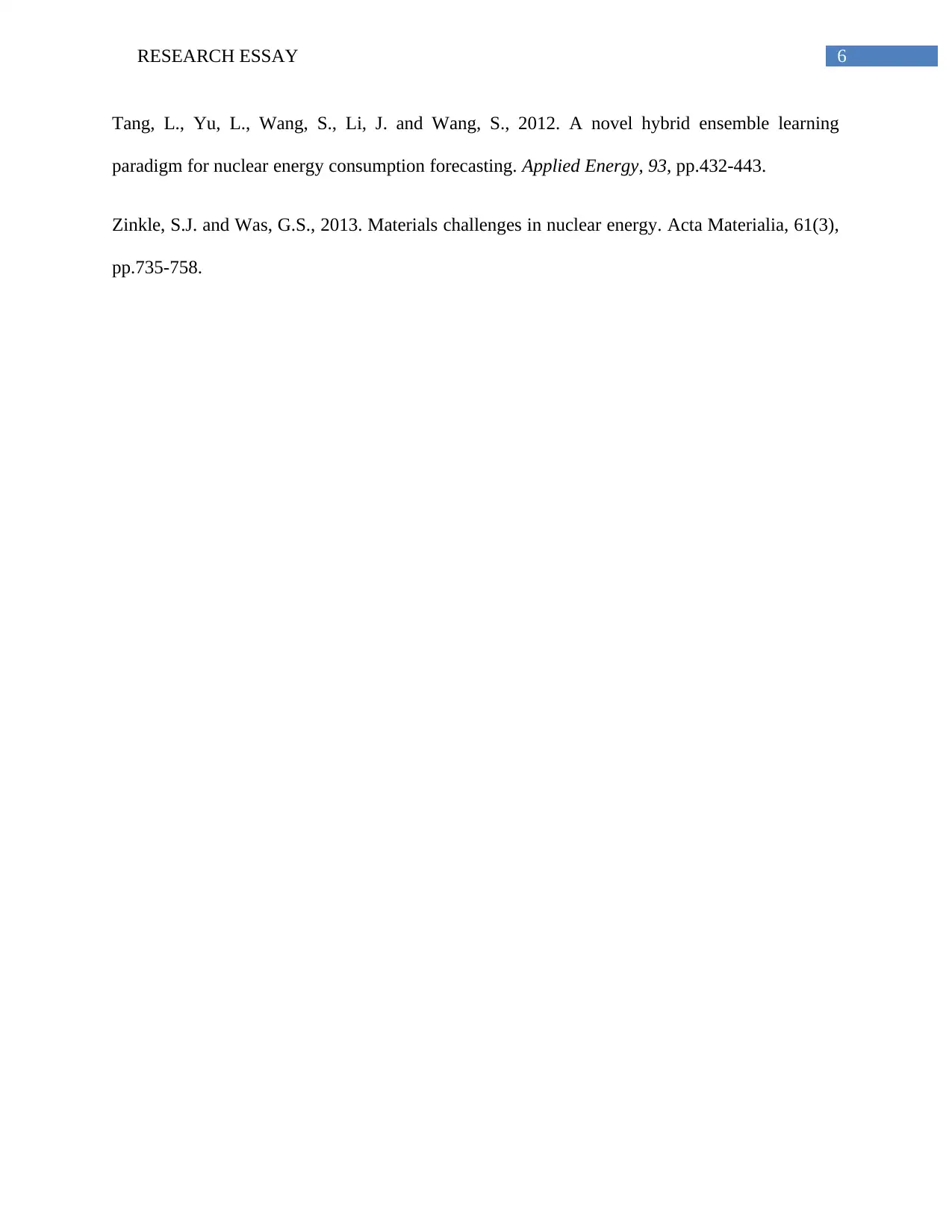
6RESEARCH ESSAY
Tang, L., Yu, L., Wang, S., Li, J. and Wang, S., 2012. A novel hybrid ensemble learning
paradigm for nuclear energy consumption forecasting. Applied Energy, 93, pp.432-443.
Zinkle, S.J. and Was, G.S., 2013. Materials challenges in nuclear energy. Acta Materialia, 61(3),
pp.735-758.
Tang, L., Yu, L., Wang, S., Li, J. and Wang, S., 2012. A novel hybrid ensemble learning
paradigm for nuclear energy consumption forecasting. Applied Energy, 93, pp.432-443.
Zinkle, S.J. and Was, G.S., 2013. Materials challenges in nuclear energy. Acta Materialia, 61(3),
pp.735-758.
1 out of 7
Related Documents
Your All-in-One AI-Powered Toolkit for Academic Success.
+13062052269
info@desklib.com
Available 24*7 on WhatsApp / Email
![[object Object]](/_next/static/media/star-bottom.7253800d.svg)
Unlock your academic potential
Copyright © 2020–2025 A2Z Services. All Rights Reserved. Developed and managed by ZUCOL.





